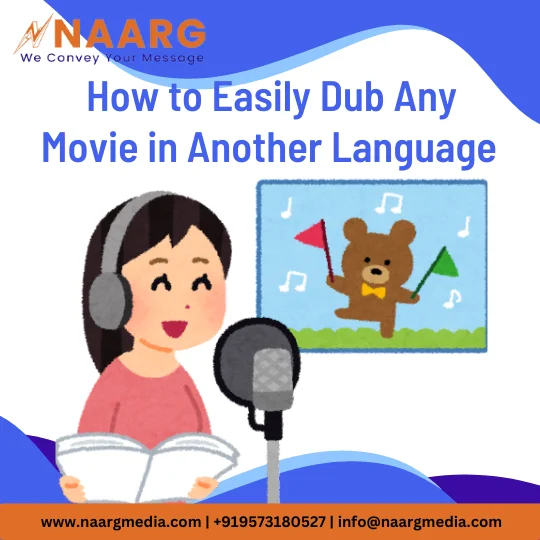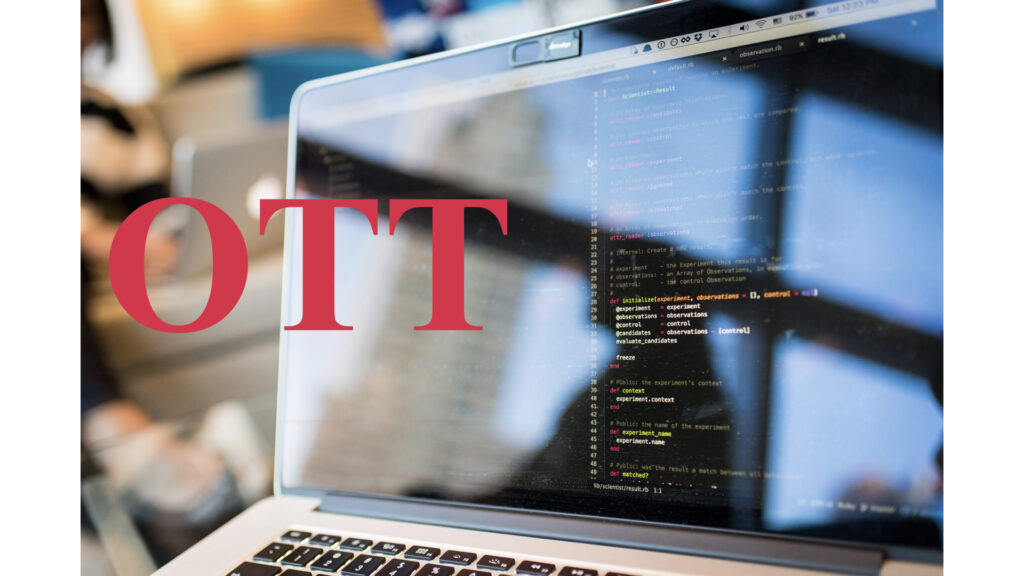Did you know that the dubbing service market is expected to touch USD 4934.83 million in 2031? There is no doubt that this proposed figure will reach this mark, as there is a growing preference for video content over text.
And this particular change has led brands and content creators to embrace videos. For this specific shift, content creators and brands are shifting towards dubbing. But knowing that your videos need to be dubbed is one thing, but understanding how to do it effectively is another.
Don’t worry! This blog will help you understand how to easily dub any movie in another language and the benefits of dubbing for a global audience.
So, let’s get started.

Why Dub Movies in Another Language?
There must have been a time when you watched a foreign movie and thought, “I wish I could hear the dialogue in my language or “How would this dialogue sound in my language?” Well! You are not alone in this; we all have been there.
But the good news is we are not living in ancient times, times have changed, and we are now embracing artificial intelligence. And today, dubbing a movie in another language is easier than ever.
As our world becomes increasingly global with each passing day, The need to stay connected and understand each other’s language is becoming crucial. Dubbing movies in other languages opens a world of possibilities for content creators and filmmakers.
Once the movie or video is accessible in multiple languages, it not only expands the viewership but also enhances global appeal. Let’s take an example of the world’s most subscribed YouTube channel, Mr. Beast.
It is the most subscribed channel in the world with 318 million subscribers. And why do you think that is possible? If you ever look at Mr. Beast’s videos, you will see that their videos are dubbed in multiple languages with subtitles of the respective language.
This inclusivity of multiple languages has turned out to be in his favor, making him the world’s most subscribed YouTube channel. With dubbing, it helps maintain the emotional impact, tone, and flow of the original video.
Dubbing is that art form that ensures that your story resonates with viewers everywhere, no matter the language they speak.
Benefits of Dubbing for Global Audiences
One of the core benefits of dubbing is that it enhances the viewing experience and makes content more accessible to people across different regions.
Listed below are some of the key benefits of dubbing for a global audience.
1. Enhanced Accessibility
The language barrier is one of the most crucial things that dubbing eliminates. It allows your audience to enjoy movies and content in their native language without relying on captions and subtitles. Thus making the viewing experience more immersive and natural.
2. Cultural Connection
Dubbing helps to culturally connect with your audience because a well-executed dub goes beyond just translating words. A well-executed dubbing adapts cultural nuances, idioms, and expressions to resonate with the target audience.
This helps in creating a deeper connection, thus ensuring that the message and emotions of the video and movie are conveyed authentically.
3. Increased Comfort for Viewers
As you know, not all audiences are comfortable with reading subtitles and captions. Especially if there are action-packed scenes where the visual elements are the key.
Dubbing allows viewers to focus entirely on the story and visuals without any distractions. Moreover, dubbing provides a smoother and more enjoyable experience.
Tools and Software Required for Dubbing Movies
A combination of specialized tools and software is required to dub a movie into another language. Just to ensure the process is smooth, efficient, and results in high-quality output.
Listed below is the breakdown of essential tools and software needed for dubbing.
1. Script Translation Software
The first and foremost step in the dubbing process is translating the movie’s script into the target language. For this process, professional translators are involved, and with the help of script translation software, the process is streamlined and ensures consistency.
Several tools like MemoQ, SDL Trados, and Smartcat assist in creating context-appropriate translations.
2. Voice Recording Software
For the voice recording, voice actors are essential as they bring the translated script to life. To capture high-quality audio, voice recording software is needed.
Voice recording software like Adobe Audition, or Pro Tools provides high-definition audio recording and editing options. All these tools allow the voice actors to record their voices while ensuring that the timing matches the original video footage.
3. Automatic Lip-Syncing Tools
To manually sync dialogues with the character’s lip movements can be extremely tiring and time-consuming. Fortunately, with the advancements in technology, various lip-synching tools are there to simplify the process.
Software, like Dubverse and Flawless AI, use machine learning to automate the lip-synching process.
4. Audio Editing Software
Once the recording is completed, the dubbed audio requires polishing. For this step, audio editing software like Reaper and Logic Pro is used and enables the audio engineer to clear up any imperfections, remove unnecessary background noise, and balance sound levels.
Also, these are responsible for ensuring that the dubbed voice matches the tone and atmosphere of the original soundtrack.
5. Video Editing Software
Once the recording and editing are done, it is time to integrate with the original movie. Video editing software like Adobe Premiere Pro and Final Cut Pro are used to sync the new audio track with video.
Ensuring that the timing is perfect and audio and video are properly synced.
How to Easily Dub Any Movie in Another Language?
Dubbing is a complex process, and that too in multiple languages, but thanks to the recent advancements in technology, this process has become easier than ever.
We have listed simple but detailed steps on how to easily dub any movie in another language.
1. Translate and Localize the Script
The first step is to translate the script into your desired language. One essential thing that should be kept in mind during the translation and localization process is that it should not be a word-to-word translation. The adaptation of cultural context should be done to ensure the content resonates with your target audience.
2. Record the Voiceover
Once the translation and localization of the script are complete, the next step is to record the voiceover. One of the best ways to achieve this is to hire professional voice actors, preferably native speakers of the target language.
This way they can understand the nuances of the language and very well understand the script and convey emotions. One essential thing to note while recording the voiceover is that to sound authentic and natural, there is no need for the voice actor to mimic every sound.
Rather, they should add modifications suitable to the target language to sound more natural.
3. Edit and Sync the Dubbed Audio
Now at this step, the original spoken dialogue is replaced with a recorded one. This is one of the highly technical aspects of dubbing, as it involves mixing the recorded audio with the appropriate SFX (sound effects).
Syncing the recorded audio with the sound effects in the original audio and lip-synching the voice with the speaker’s mouth movement is a crucial step.
Therefore, some editing is also needed to modify the recorded dialogue just to better fit the video’s timing and ensure smooth transitions between scenes.
Common Mistakes in Movie Dubbing and How to Avoid Them
Dubbing is a process that requires careful attention to detail because even a small error can disrupt the overall viewing experience.
We have listed some common mistakes in movie dubbing and what you can do to avoid them.
1. Poor Lip-Syncing
One of the most common and noticeable mistakes you must have seen is misaligned lip-syncing. Poor lip sync is where the dubbed dialogue doesn’t match the character’s mouth movements.
This can break the overall viewing experience of the audience. To avoid this poor lip-sync error, try using advanced lip-synching tools to automate synchronization.
2. Literal Translation
Whenever we do word-for-word translation, it loses its essence, and the same is the case with dubbing. With literal translation in dubbing, it often loses the essence of the original dialogue.
Thus, further leading to awkward phrasing or miscommunication of the movie’s intended meaning. To avoid such errors, you need to work with professional translators who understand the nuances of both the source and target languages. Try to focus on localization rather than direct translation.
3. Ignoring Cultural Context
When you fail to adapt the script to the cultural context of the target audience, it can result in dialogue that feels out of place, confusing the viewers. So, to avoid such mistakes, work with native speakers or cultural consultants to adjust certain references or jokes that might not translate well.
This will ensure the content feels more relevant and relatable to the audience. To easily dub any movie in another language, it is essential to focus on translation accuracy, voice performance, and technical precision.
With all these factors in place, you can ensure that your dubbed movie resonates with your audiences around the world without compromising the original film’s integrity.
Having Naarg Media, the best dubbing service provider, on board can make a big difference in how your film is perceived.
Contact us today to know more.

